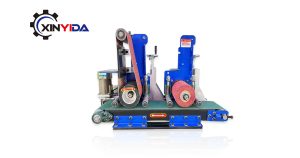In the world of industrial manufacturing, construction, and automotive finishing, the quality of pipes and their surfaces is crucial. Pipe buffing machines play a pivotal role in ensuring these pipes meet the highest standards of appearance and functionality. This article delves into the functions of pipe buffing machines, their types, and their significance across various industries.
Introduction
Pipe buffing machines are essential tools used to enhance the quality and appearance of pipes. These machines are designed to smooth, polish, clean, and prepare pipes for further processing or use. In industries where precision and surface quality are paramount, such as in manufacturing, construction, and automotive sectors, the function of these machines cannot be overstated.
What is a Pipe Buffing Machine?
A pipe buffing machine is a specialized equipment used to refine the surface of pipes. Its primary purpose is to improve the pipe’s finish and remove any surface imperfections. The basic components of a pipe buffing machine include abrasive wheels or belts, a motor, and a support frame. The abrasive wheels or belts are crucial for the actual buffing process, while the motor provides the necessary power to drive these components. The support frame holds everything in place and ensures stability during operation.
Functions of a Pipe Buffing Machine
A. Surface Smoothing
One of the fundamental functions of a pipe buffing machine is surface smoothing. Pipes often come with imperfections such as scratches, dents, or rough spots from the manufacturing process. Buffing machines address these issues by using abrasive materials to gently remove surface irregularities, resulting in a smoother and more uniform surface.
B. Polishing
Buffing machines are also used for polishing pipes to achieve a high-gloss finish. This is particularly important in applications where the aesthetic appearance of the pipe is crucial, such as in decorative elements or high-end installations. The polishing process enhances the visual appeal of the pipe, giving it a shiny and reflective surface that signifies quality and attention to detail.
C. Cleaning
Another critical function of pipe buffing machines is cleaning. Over time, pipes can accumulate oxidation, rust, or other contaminants that compromise their performance and appearance. Buffing machines can effectively remove these impurities, restoring the pipe’s original condition. This cleaning process is essential for ensuring the longevity and efficiency of the pipe in its intended application.
D. Preparing for Coatings
Before applying paints or protective coatings, it’s essential to prepare the pipe surface to ensure optimal adhesion. Pipe buffing machines help in this preparation by creating a surface that enhances the bonding of coatings. This step is crucial for achieving a durable and long-lasting finish, which is particularly important in environments exposed to harsh conditions.
Types of Pipe Buffing Machines
A. Manual Buffing Machines
Manual buffing machines require the operator to control the buffing process manually. These machines are often used for smaller batches or for pipes with specific requirements. They offer flexibility and control but may require more time and effort from the operator compared to automated systems.
B. Automatic Buffing Machines
Automatic buffing machines are designed to handle larger volumes of pipes with minimal human intervention. These machines feature automated feeding and buffing processes, which increase efficiency and consistency. They are ideal for high-volume production environments where speed and uniformity are critical.
C. Specialized Buffing Machines
Specialized buffing machines are tailored for specific types of pipes or materials. For example, machines designed for polishing stainless steel pipes may have different abrasive materials or settings compared to those used for other metals. These specialized machines ensure that the unique properties of different pipe materials are adequately addressed during the buffing process.
How Pipe Buffing Machines Work
A. Operation Mechanism
Pipe buffing machines operate by rotating abrasive wheels or belts at high speeds. The pipe is fed through these abrasive components, which smooth and polish the surface as it moves. The machine’s settings, including speed and pressure, can be adjusted based on the specific requirements of the pipe and the desired finish.
B. Key Features
The effectiveness of a pipe buffing machine depends on several key features, including the type of abrasive materials used, the speed of operation, and the pressure applied during buffing. High-quality abrasive materials ensure effective surface treatment, while adjustable speed and pressure settings allow for customization based on different pipe sizes and types.
Applications in Various Industries
A. Manufacturing
In manufacturing, pipe buffing machines are used to refine the surfaces of pipes used in machinery and equipment. A smooth and polished surface improves the performance and durability of these pipes, contributing to the overall efficiency of the manufacturing process.
B. Construction
In the construction industry, buffing machines prepare pipes for installation by ensuring they are free of contaminants and defects. This preparation is crucial for achieving reliable and long-lasting installations in various building projects.
C. Automotive
For automotive applications, buffing machines provide a high-gloss finish for exhaust pipes and other components. This not only enhances the appearance of vehicles but also contributes to their overall performance and durability.
Maintenance and Care
To ensure the longevity and optimal performance of pipe buffing machines, regular maintenance is essential. This includes cleaning the machine after use, inspecting abrasive materials for wear, and addressing any mechanical issues promptly. Proper maintenance helps prevent breakdowns and ensures consistent results.
Conclusion
Pipe buffing machines play a vital role in enhancing the quality and appearance of pipes across various industries. By smoothing, polishing, cleaning, and preparing pipes, these machines contribute to better performance, durability, and aesthetics. Understanding their functions and types helps in selecting the right machine for specific needs, ultimately leading to more efficient and effective pipe processing.


